Basic Dye Mixtures For Aramid Fibres
MURGATROYD; ADRIAN ; et al.
U.S. patent application number 16/095176 was filed with the patent office on 2019-11-07 for basic dye mixtures for aramid fibres. The applicant listed for this patent is DyStar Colours Distribution GmbH. Invention is credited to Brian CONNOLLY, Clemens GRUND, Manfred HOPPE, ADRIAN MURGATROYD, Thomas STEPANSKI.
| Application Number | 20190338461 16/095176 |
| Document ID | / |
| Family ID | 57629289 |
| Filed Date | 2019-11-07 |
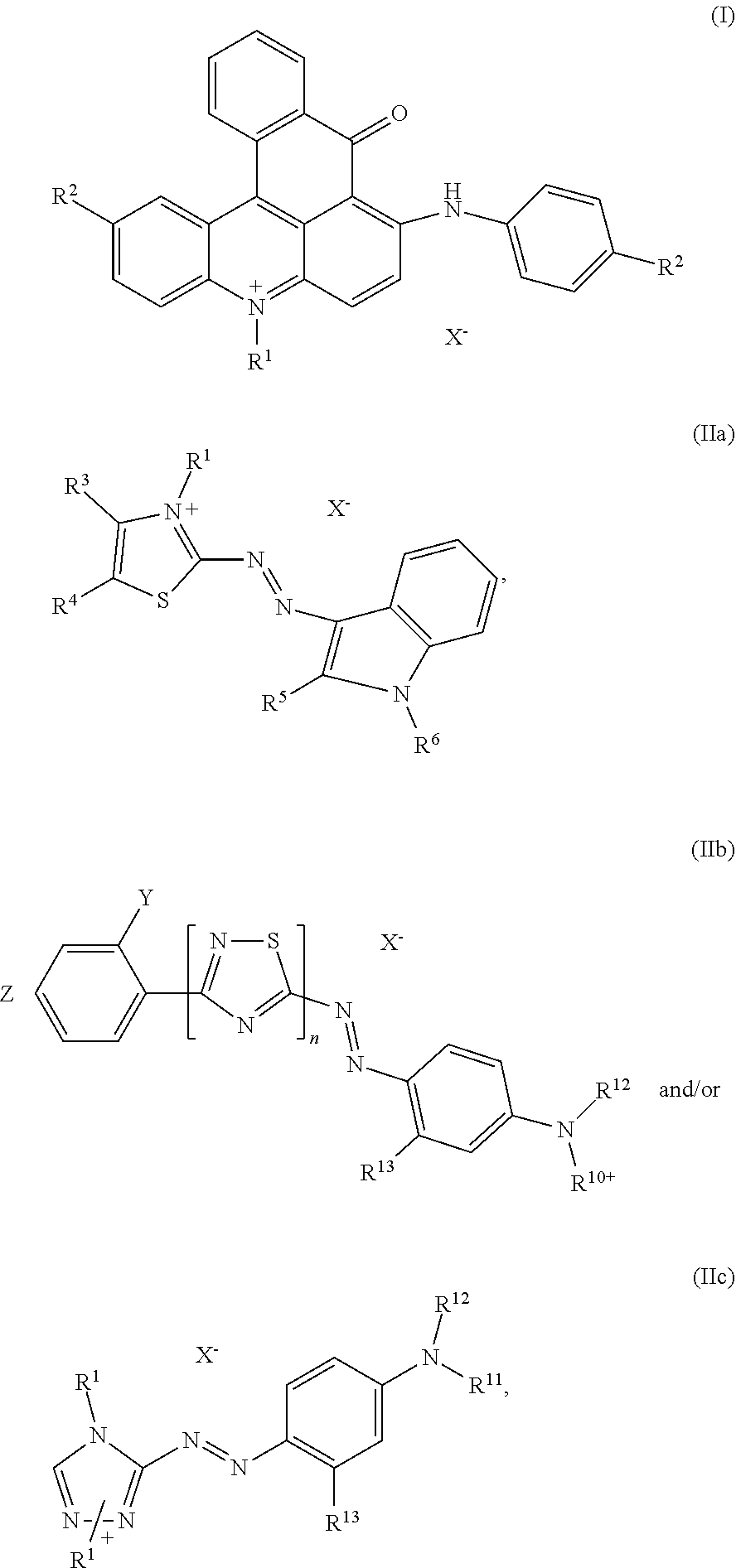
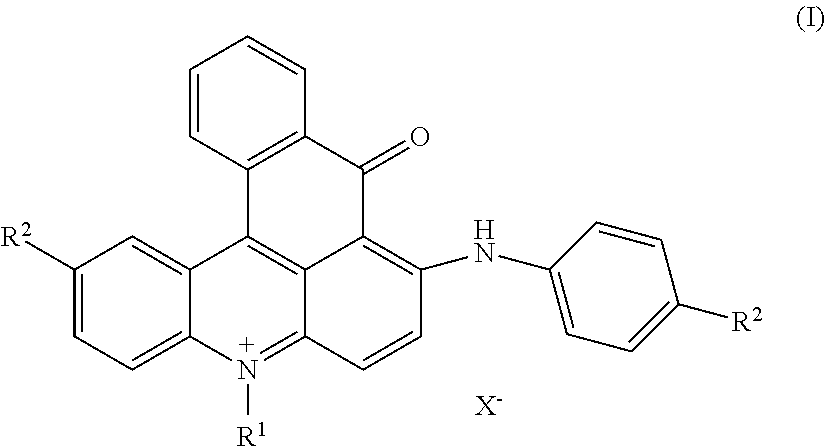


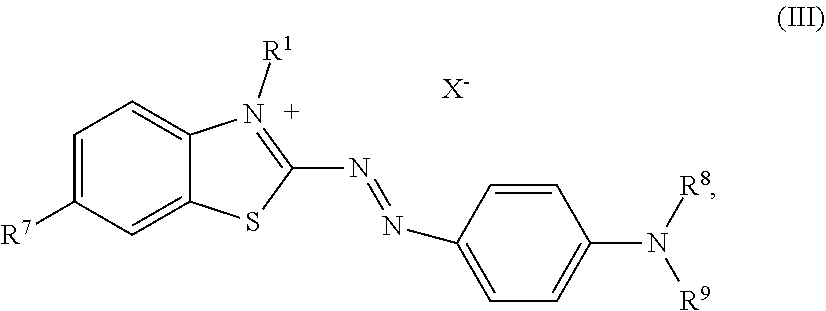
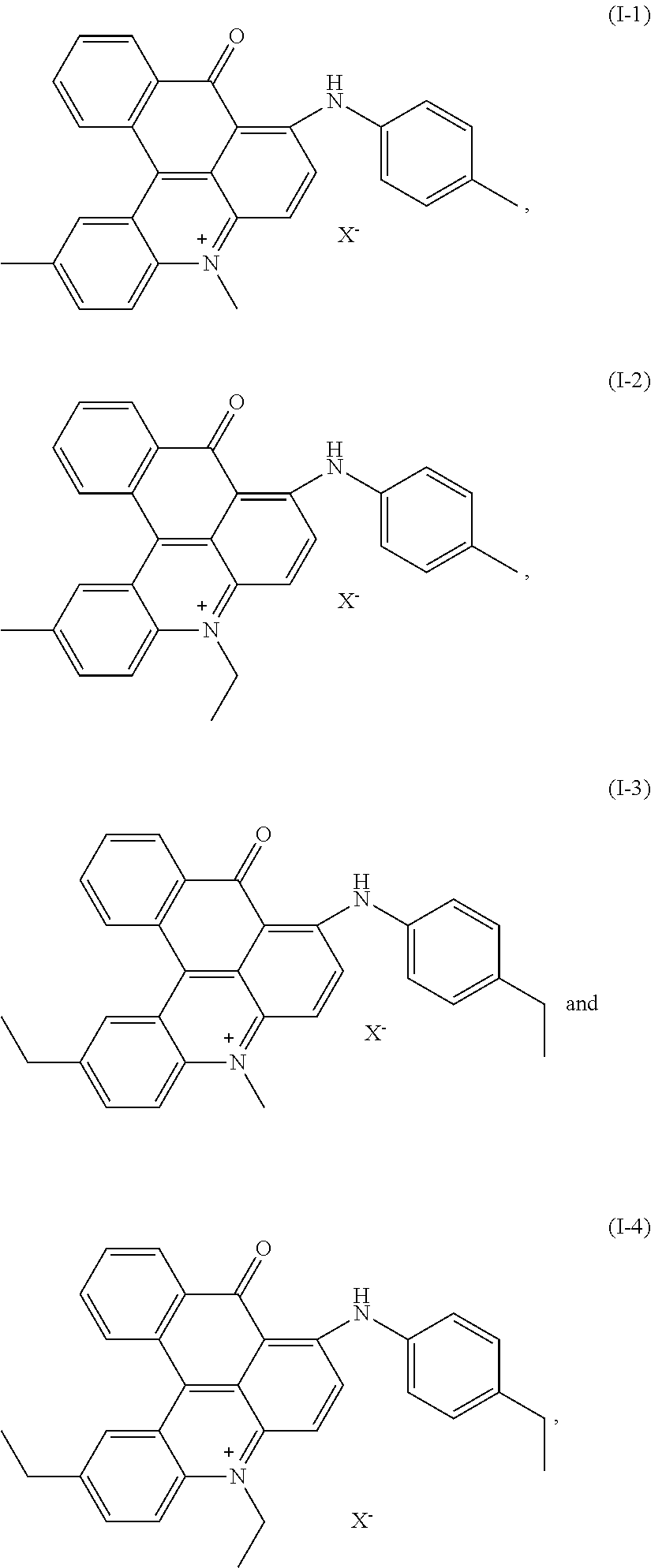

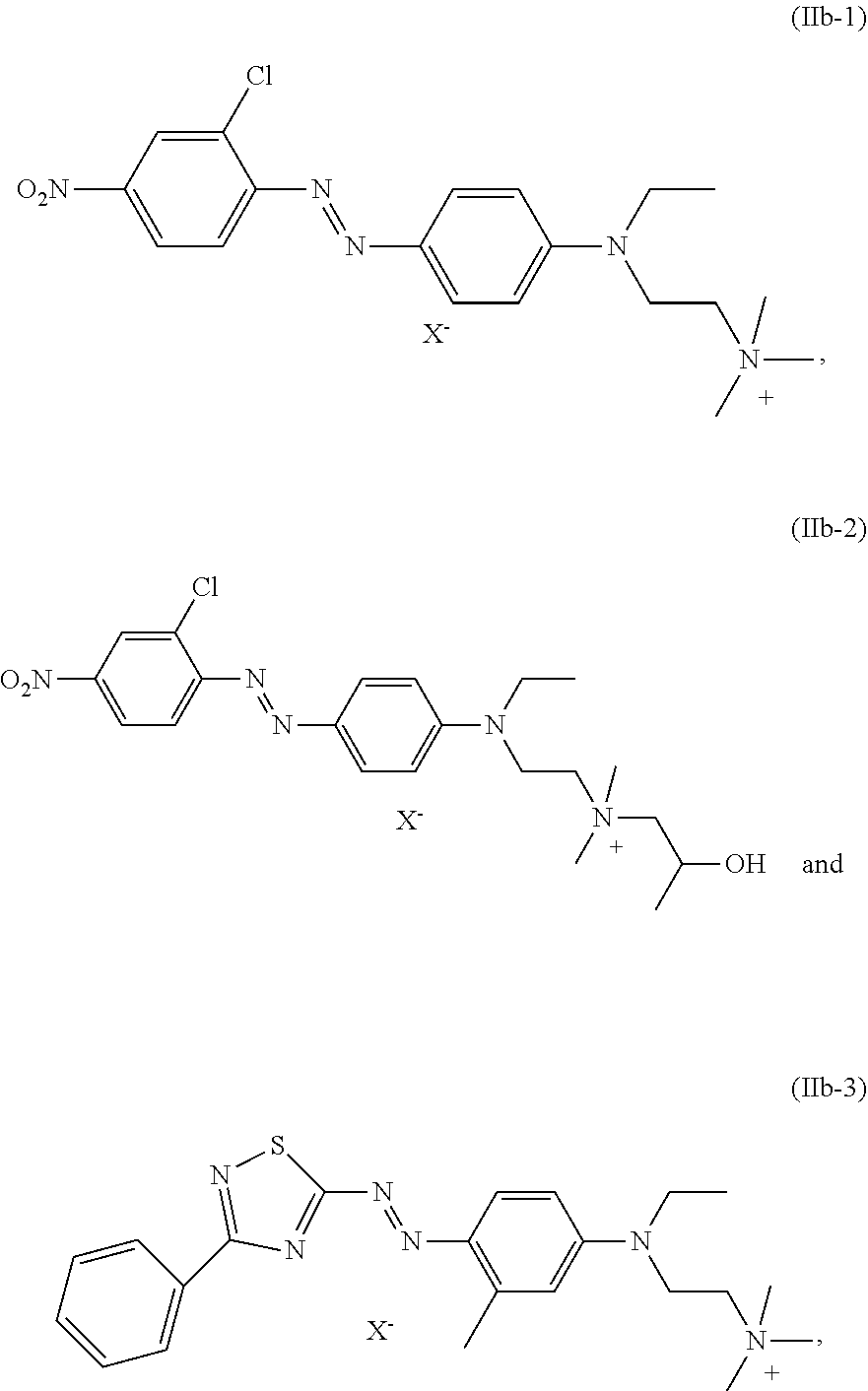
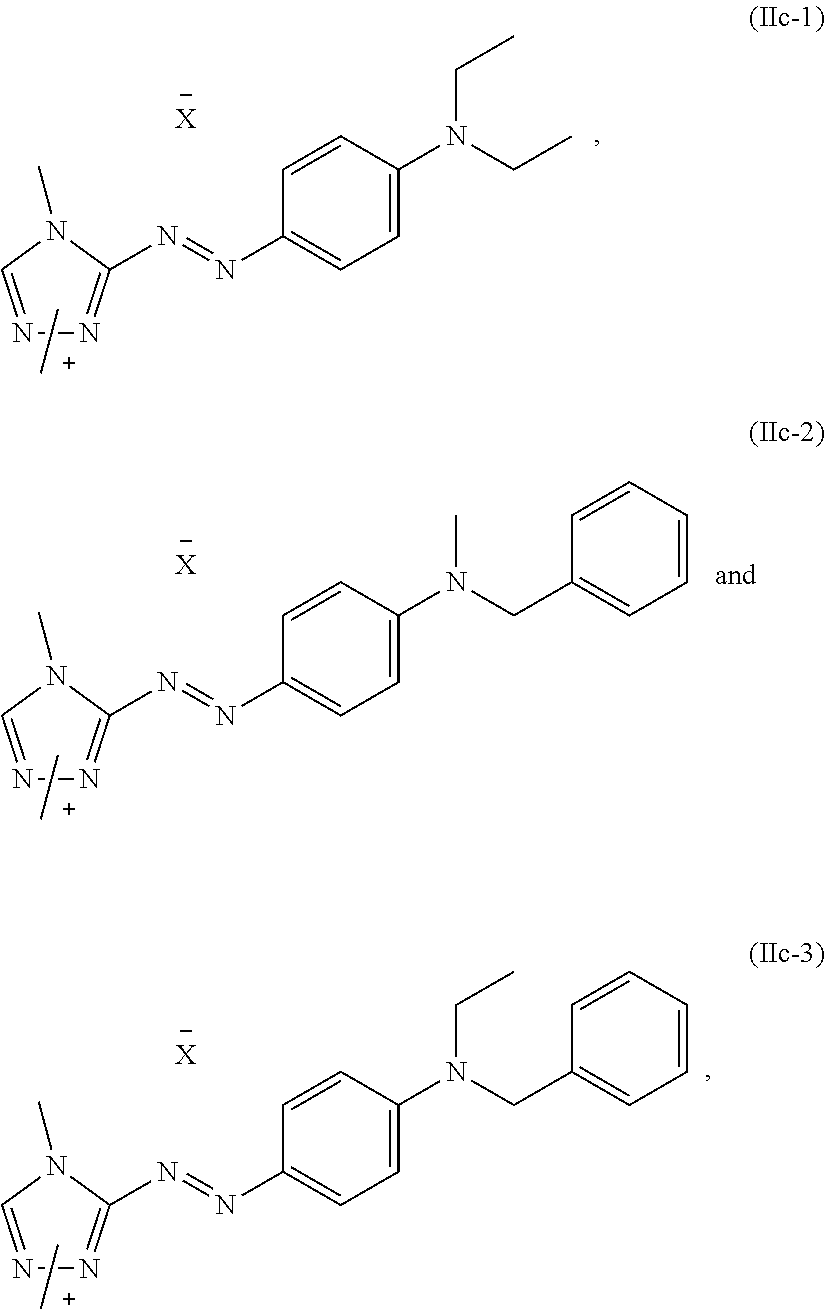


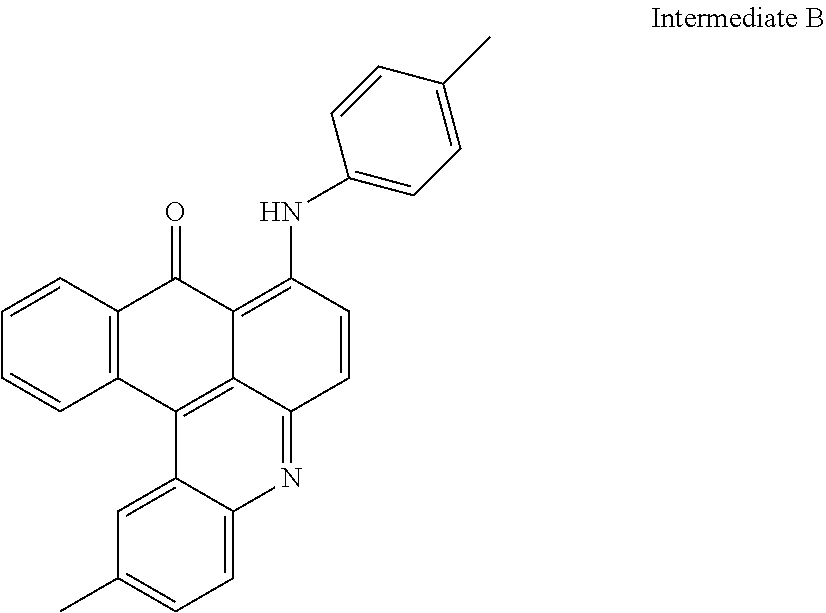
View All Diagrams
| United States Patent Application | 20190338461 |
| Kind Code | A1 |
| MURGATROYD; ADRIAN ; et al. | November 7, 2019 |
BASIC DYE MIXTURES FOR ARAMID FIBRES
Abstract
The present invention is directed to dye mixtures comprising structures of formula and their production and their use for dyeing textiles and in particular for dyeing aramid fibres. ##STR00001##
| Inventors: | MURGATROYD; ADRIAN; (Frankfurt am Main, DE) ; HOPPE; Manfred; (Kurten, DE) ; GRUND; Clemens; (Hattersheim, DE) ; CONNOLLY; Brian; (Lohmar, DE) ; STEPANSKI; Thomas; (Koln, DE) | ||||||||||
| Applicant: |
|
||||||||||
|---|---|---|---|---|---|---|---|---|---|---|---|
| Family ID: | 57629289 | ||||||||||
| Appl. No.: | 16/095176 | ||||||||||
| Filed: | December 7, 2017 | ||||||||||
| PCT Filed: | December 7, 2017 | ||||||||||
| PCT NO: | PCT/EP2017/081771 | ||||||||||
| 371 Date: | October 19, 2018 |
| Current U.S. Class: | 1/1 |
| Current CPC Class: | D06P 3/24 20130101; D06P 3/242 20130101; D06P 3/28 20130101; D06P 1/42 20130101; C09B 67/0041 20130101; D06P 1/10 20130101; D06P 1/20 20130101; C09B 67/0051 20130101 |
| International Class: | D06P 1/42 20060101 D06P001/42; C09B 67/22 20060101 C09B067/22; D06P 1/10 20060101 D06P001/10 |
Foreign Application Data
| Date | Code | Application Number |
|---|---|---|
| Dec 15, 2016 | EP | 16204228.7 |
Claims
1. A dye mixture comprising at least one dye of formula (I) ##STR00014## and at least one dye selected from the group consisting of dyes of formula (IIa), (IIb) and (IIc) ##STR00015## wherein independent from each other R.sup.1 and R.sup.6 is C.sub.1-C.sub.4-alkyl, R.sup.3, R.sup.4 and R.sup.13 is hydrogen or (C.sub.1-C.sub.4)-alkyl, R.sup.5 is hydrogen, (C.sub.1-C.sub.4)-alkyl or phenyl, R.sup.7 is hydrogen, (C.sub.1-C.sub.4)-alkyl or (C.sub.1-C.sub.4)-alkoxy, R.sup.10+ is --(CH.sub.2).sub.p--N.sup.+R.sup.1(CH.sub.3).sub.2 or --(CH.sub.2).sub.p--N.sup.+R.sup.1(CH.sub.3)--CH.sub.2--CHCH.sub.3--OH, wherein p is 2 to 4, R.sup.2, R.sup.11 and R.sup.12 is (C.sub.1-C.sub.4)-alkyl, (C.sub.1-C.sub.4)-alkyl substituted by halogen, phenyl or benzyl substituted by (C.sub.1-C.sub.8)-alkyl, n is 0 or 1, X.sup.- is an anion, Y is hydrogen, cyano or halogen and z is hydrogen, nitro, cyano or halogen.
2. The dye mixture according to claim 1, further comprising at least one dye of formula (III) ##STR00016## wherein independent from each other R.sup.1 is C.sub.1-C.sub.4-alkyl, R.sup.7 is hydrogen, (C.sub.1-C.sub.4)-alkyl or (C.sub.1-C.sub.4)-alkoxy, R.sup.8 is hydrogen or (C.sub.1-C.sub.4)-alkyl, R.sup.9 is (C.sub.1-C.sub.4)-alkyl, (C.sub.1-C.sub.4)-alkoxy or --(CH.sub.2).sub.m--OH, wherein m is 2 to 4, and X.sup.- is an anion.
3. The dye mixture according to claim 1, wherein independent from each other R.sup.1, R.sup.2, R.sup.6, R.sup.8 and R.sup.12 is (C.sub.1-C.sub.2)-alkyl, R.sup.3, R.sup.4 and R.sup.13 is hydrogen or (C.sub.1-C.sub.2)-alkyl, R.sup.5 is (C.sub.1-C.sub.2)-alkyl or phenyl, R.sup.7 is (C.sub.1-C.sub.2)-alkyl or (C.sub.1-C.sub.2)-alkoxy, R.sup.9 is (C.sub.1-C.sub.2)-alkyl, (C.sub.1-C.sub.2)-alkoxy or --(CH.sub.2).sub.m--OH, wherein m is 2 to 4, R.sup.10+ is --(CH.sub.2).sub.p--N.sup.+R.sup.1(CH.sub.3).sub.2 or --(CH.sub.2).sub.p--N.sup.+R.sup.1(CH.sub.3)--CH.sub.2--CHCH.sub.3--OH, wherein with p is 2 or 3, R.sup.11 is (C.sub.1-C.sub.4)-alkyl or benzyl, n is 0 or 1, whereby Y is cyano or halogen and z is nitro, cyano or halogen when n is 0 or Y and z both are hydrogen when n is 1 and X.sup.- is an anion.
4. The dye mixture according to claim 1, wherein at least one dye of formula (I) is selected from the group consisting of: ##STR00017## ##STR00018## wherein X.sup.- is an anion.
5. The dye mixture according to claim 1, wherein at least one dye of formula (IIa) is present and is selected from the group consisting of: ##STR00019## wherein X.sup.- is an anion.
6. The dye mixture according to claim 1, wherein at least one dye of formula (IIb) is present and is selected from the group consisting of: ##STR00020## wherein X.sup.- is an anion.
7. The dye mixture according to claim 1, wherein at least one dye of formula (IIc) is present and is selected from the group consisting of: ##STR00021## wherein X.sup.- is an anion.
8. The dye mixture according to claim 2, wherein at least one dye of formula (III) is present and is selected from the group consisting of: ##STR00022## wherein X.sup.- is an anion.
9. The dye mixture according to claim 4, comprising dyes of formula (I-1) and/or (I-2), (IIa-1) and/or (IIa-2) ##STR00023##
10. The dye mixture according to claim 9, comprising dyes of formula (I-1) and (IIa-1) and (III-3).
11. The dye mixture according to claim 1, wherein the anion is selected from the group consisting of halogen, sulfate, hydrogensulfate, aminosulfate, nitrate, phosphate, dihydrogenphosphate, hydrogen phosphate, polyphosphate, hydrogencarbonate, carbonate, methosulfate, ethosulfate, cyanate, tri-chlorozincate, tetrachlorozincate, (C.sub.1-C.sub.4)-alkylsulfonate, benzenesulfonate, naphthalinsulfonates, borate, tetra-borofluorate, (C.sub.1-C.sub.4)-alkylcarboxylate, hydroxy-(C.sub.1-C.sub.4)-alkylcarboxylate, benzenecarboxylate and naphthalincarboxylate.
12. The dye mixture according to claim 1, wherein the anion is selected from the group consisting of formiate, acetate, propionate, lactate, benzoate, chloride, trichlorozincate, tetrachlorozincate, methosulfate and ethosulfate.
13. The dye mixture according to claim 1, comprising dyes of formula (I): 1 to 99 and (IIa)/(IIb)/(IIc): 99 to 1 weight % of the total amount of dyes in the dye mixture.
14. The dye mixture according to claim 2, comprising dyes of formula (I): 50 to 90, (IIa)/(IIb)/(IIc): 45 to 5, (III): 30 to 5, weight % of the total amount of dyes in the dye mixture.
15. The dye mixture according to claim 2, comprising dyes of formula (I): 50 to 80, (IIa)/(IIb)/(IIc): 30 to 10, (III): 25 to 10, weight % of the total amount of dyes in the dye mixture.
16. A solution for dying comprising the dye mixture according to claim 1.
17. A process for the production of the dye mixture according claim 1, comprising a) mixing the components of the dye mixture, and b) homogenizing the mixture obtained in step a).
18. A process for dyeing or printing material, comprising contacting the material with the dye mixture according to claim 1.
19. A process for dyeing or printing material, comprising contacting the material the solution according to claim 16.
Description
[0001] The present invention relates to the field of Basic dyes, which are well known and are used for dyeing and printing of synthetic acrylic (Polyacrylonitrile, PAN) fibre material. In addition basic dyes can be used to colour aromatic polyamide fibre types (Aramid fibres). Aramid fibres are known under various trade names.
[0002] Due to its extremely high crystallinity and compactness the dyeing process of Aramid fibres is difficult and has been widely evaluated and published, including the usage of some cationic dyes (U.S. Pat. Nos. 3,674,420, 4,780,105 and US 2002/0144362).
[0003] Besides the problems related to the dyeing processes of aramid fibres there are also major deficiencies in the resulting fastness properties of the dyed fabric, especially in light fastness.
[0004] It is an object of the present invention to provide improved mixtures of basic dyes, which are suitable for dyeing synthetic m-Aramid fibre material and are delivering improved fastness properties, especially in lightfastness, in the reddish, violet, navy, brown, khaki, olive, green and black shade area.
[0005] The present invention is directed to dye mixtures comprising at least one dye of formula (I)
##STR00002##
and at least one dye selected from the list consisting of dyes of formula (IIa), (IIb) and (IIc)
##STR00003##
wherein independent from each other R.sup.1 and R.sup.6 is C.sub.1-C.sub.4-alkyl, R.sup.3, R.sup.4 and R.sup.13 is hydrogen or (C.sub.1-C.sub.4)-alkyl, R.sup.5 is hydrogen, (C.sub.1-C.sub.4)-alkyl or phenyl, R.sup.7 is hydrogen, (C.sub.1-C.sub.4)-alkyl or (C.sub.1-C.sub.4)-alkoxy, R.sup.10+ is --(CH.sub.2).sub.p--N.sup.+R.sup.1(CH.sub.3).sub.2 or --(CH.sub.2).sub.p--N.sup.+R.sup.1(CH.sub.3)--CH.sub.2--CHCH.sub.3--OH, [0006] wherein p is 2 to 4, R.sup.2, R.sup.11 and R.sup.12 is (C.sub.1-C.sub.4)-alkyl, (C.sub.1-C.sub.4)-alkyl substituted by halogen, phenyl or benzyl substituted by (C.sub.1-C.sub.8)-alkyl, n is 0 or 1, X.sup.- is an anion, Y is hydrogen, cyano or halogen and z is hydrogen, nitro, cyano or halogen.
[0007] Dyes of general structure (I) can be synthesized e.g. as described below in the example section. The dyes of general structure (II) can by synthesised according to "Industrial Dyes" (Editor: Klaus Hunger) Wiley-VCH Verlag GmbH & Co. KGaA, Weinheim, 2003; Chapter 3.7, Page 227 ff; ISBN: 3-527-30426-6. In particular synthesis of structures of general formula (IIa) are disclosed in JP 2011184493, synthesis for those of general structure (IIb) are disclosed in DE-OS 2915323 and those or structure (IIc) in GB 1282281.
[0008] Dye (IIc) evolves from synthesis as two different isomers (IIc-a) and (IIc-b) represented both by (IIc)
##STR00004##
[0009] Preferred are dye mixtures, comprising one dye according to formula (I) and one dye according to formula (II). Dye mixtures comprising one dye of formula (I) and two or more dyes of formula (II) form another preferred aspect of the present invention. As such dye mixtures having a composition comprising [0010] one dye according to formula (I) and one dye according to any one of (IIa), (IIb) and (IIc), [0011] one dye of formula (I), one dye of formula (IIa) and one dye of formula (IIb), [0012] one dye of formula (I), one dye of formula (IIa) and one dye of formula (IIc), [0013] one dye of formula (I), one dye of formula (IIb) and one dye of formula (IIc) and [0014] one dye of formula (I), one dye of formula (IIa), one dye of formula (IIb) and one dye of formula (IIc) all form preferred embodiments of the present invention.
[0015] More preferred is a dye mixture as described above, comprising at least one dye of formula (III)
##STR00005##
wherein independent from each other R.sup.1 is C.sub.1-C.sub.4-alkyl, R.sup.7 is hydrogen, (C.sub.1-C.sub.4)-alkyl or (C.sub.1-C.sub.4)-alkoxy, R.sup.8 is hydrogen or (C.sub.1-C.sub.4)-alkyl, R.sup.9 is (C.sub.1-C.sub.4)-alkyl, (C.sub.1-C.sub.4)-alkoxy or --(CH.sub.2).sub.m--OH, [0016] wherein m is 2 to 4, and X.sup.- is an anion.
[0017] Also the dyes of general structure (III) can by synthesised according to "Industrial Dyes" (Editor: Klaus Hunger) Wiley-VCH Verlag GmbH & Co. KGaA, Weinheim, 2003; Chapter 3.7, Page 227 ff; ISBN: 3-527-30426-6 or according to e.g. CH 745871 or DE-OS 2314406.
[0018] Even more preferred is a dye mixture as described above, wherein independent from each other
R.sup.1, R.sup.2, R.sup.6, R.sup.8 and R.sup.12 is (C.sub.1-C.sub.2)-alkyl, R.sup.3, R.sup.4 and R.sup.13 is hydrogen or (C.sub.1-C.sub.2)-alkyl, R.sup.5 is (C.sub.1-C.sub.2)-alkyl or phenyl, R.sup.7 is (C.sub.1-C.sub.2)-alkyl or (C.sub.1-C.sub.2)-alkoxy, R.sup.9 is (C.sub.1-C.sub.2)-alkyl, (C.sub.1-C.sub.2)-alkoxy or --(CH.sub.2).sub.m--OH, [0019] wherein m is 2 to 4, R.sup.10+ is --(CH.sub.2).sub.p--N.sup.+R.sup.1(CH.sub.3).sub.2 or --(CH.sub.2).sub.p--N.sup.+R.sup.1(CH.sub.3)--CH.sub.2--CHCH.sub.3--OH, [0020] wherein with p is 2 or 3, R.sup.11 is (C.sub.1-C.sub.4)-alkyl or benzyl, n is 0 or 1, [0021] whereby [0022] Y is cyano or halogen and z is nitro, cyano or halogen when n is 0 or [0023] Y and z both are hydrogen when n is 1 and X.sup.- is an anion.
[0024] Within these groups of dye mixtures there exist preferred dye mixtures based on preferred selections of single dyes:
[0025] Accordingly a dye mixture as described above is particularly preferred, wherein at least one dye of formula (I) is selected from the group consisting of:
##STR00006##
wherein X.sup.- is an anion.
[0026] Also a dye mixture as described above, wherein at least one dye of formula (IIa) is present and is selected from the group consisting of:
##STR00007##
wherein X.sup.- is an anion is particularly preferred.
[0027] Also particularly preferred is a dye mixture as described above, wherein at least one dye of formula (IIb) is present and is selected from the group consisting of:
##STR00008##
wherein X.sup.- is an anion.
[0028] A dye mixture as described above, wherein at least one dye of formula (IIc) is present and is selected from the list consisting of:
##STR00009##
wherein X.sup.- is an anion, forms another particularly preferred embodiment of the present invention.
[0029] A dye mixture as described above, wherein at least one dye of formula (III) is present and is selected from the list consisting of:
##STR00010##
wherein X.sup.- is an anion is even more preferred.
[0030] Combinations of dyes according to the invention are preferred, wherein the single dyes are preferred members of the mixture as is outlined above. A dye mixture, comprising two or more preferred dyes according to the selections above is even more preferred. A dye mixture as described above, comprising dyes of formula
(I-1) and/or (I-2), (IIa-1) and/or (IIa-2) and (III-1) and/or (III-3) is particularly preferred and a dye mixture as described above, comprising dyes of formula
(I-1) and (IIa-1) and (III-3)
[0031] is most preferred.
[0032] Also regarding the selection of the counterion of the cationic dyes used in the dye mixtures of the present invention there exist preferred ones. Accordingly a dye mixture as described above, wherein the anion is selected from the group consisting of halogen, sulfate, hydrogensulfate, aminosulfate, nitrate, phosphate, dihydrogenphosphate, hydrogenphosphate, polyphosphate, hydrogencarbonate, carbonate, methosulfate, ethosulfate, cyanate, tri-chlorozincate, tetrachlorozincate, (C.sub.1-C.sub.4)-alkylsulfonate, benzenesulfonate, naphthalinsulfonates, borate, tetra-borofluorate, (C.sub.1-C.sub.4)-alkylcarboxylate, hydroxy-(C.sub.1-C.sub.4)-alkylcarboxylate, benzenecarboxylate and naphthalincarboxylate is preferred. More preferred is a dye mixture as described above, wherein the anion is selected from the group consisting of formiate, acetate, propionate, lactate, benzoate, chloride, trichlorozincate, tetrachlorozincate, methosulfate and ethosulfate.
[0033] The proportions of the single dyes in the dye mixtures of the present invention may vary in a broad range and a dye mixture as described above, comprising dyes of formula
(I): 1 to 99 and
(IIa)/(IIb)/(IIc): 99 to 1
[0034] weight % of the total amount of dyes in the dye mixture is preferred. The total amount of dyes represents 100 wt % in the dye mixture.
[0035] More preferred is a dye mixture as described above, comprising dyes of formula
(I): 50 to 90,
(IIa)/(IIb)/(IIc): 45 to 5,
(III): 30 to 5
[0036] weight % of the total amount of dyes in the dye mixture.
[0037] And most preferred is a dye mixture as described above, comprising dyes of formula
(I): 50 to 80,
(IIa)/(IIb)/(IIc): 30 to 10,
(III): 25 to 10,
[0038] weight % of the total amount of dyes in the dye mixture.
[0039] A solution for dyeing comprising a dye mixture as described above forms another preferred embodiment of the present invention.
[0040] Also a process for the production of a dye mixture as described above, comprising
a) mixing the components of the dye mixture, b) homogenizing the mixture obtained in step a) forms an aspect of the present invention.
[0041] A process for dyeing or printing material, comprising contacting the material with a dye mixture as described above and/or a solution as described above forms yet another aspect of the present invention.
EXAMPLES
Example A--Synthesis
[0042] To 370 parts of n-Butanol and 41 parts of water 109.8 parts (0.517 mol) of Quinizarine (CAS 81-64-1) and 14.4 parts of Leuco-quinizarine (CAS 17648-03-2) were added under stirring. To this mixture 9.6 parts Boric acid (CAS 10043-35-3) and 122 parts (1.14 mol) of p-Toluidin (CAS106-49-0) were added.
[0043] The reaction mixture was heated under stirring to reflux (96.degree. C.) and kept for 20 hours under stirring.
[0044] The reaction mixture was then cooled down to 50 to 60.degree. C. and the product was filtered and washed with methanol and demineralized water.
[0045] After drying under vacuum conditions 130 parts of Intermediate A were obtained.
##STR00011##
Example B--Synthesis
[0046] 10 parts of Precursor A were added to 265 parts of 55% Sulfuric acid at 0 to 5.degree. C. under stirring.
[0047] The reaction mixture was then heated up to 125.degree. C. under stirring and kept at this temperature for 11 hours.
[0048] The Mixture was cooled down to 25.degree. C. under stirring, a black suspension was observed. The mixture was filtered and washed with water.
[0049] The filtered solid was re-slurried in 200 ml of demineralized water and the pH was adjusted to pH 11 with NH.sub.4OH solution and stirred for 3 hours.
[0050] The reddish Brown solid product was again filtrated and washed with demineralized water and dried under vacuum conditions to deliver: 9.2 g of Intermediate B
##STR00012##
Example C--Synthesis
[0051] 20 parts of dry Intermediate B (<0.5% water content) and 2 parts of MgO were added to 200 parts of dry Chlorobenzene.
[0052] The mixture was stirred and heated up to 135.degree. C. and stirred for 30 to 45 min until a solution was reached. 20 parts of Dimethylsulfate were added and the mixture was stirred for 4 h at 120 to 125.degree. C. The reaction mixture was cooled down to 70 to 75.degree. C. and 20 parts of water and 10 parts of diluted Hydrochloric acid were added and the mixture was stirred for 1 h.
[0053] The excess of Dimethylsulfate was destroyed by cooling down the mixture to 50 to 55.degree. C. and adding 10 parts of diluted hydrochloric acid and stirring 2 h at 50 to 55.degree. C. Then the mixture was filtrated, washed with Chlorobenzene Methanol and water.
[0054] After drying under vacuum conditions 12 g of the final dye (I-1) with X.sup.- .dbd.CH.sub.3SO.sub.4.sup.- were obtained.
##STR00013##
Example D--Powder Formulation
[0055] 36 parts of dye (I-2), with X.sup.- .dbd.CH.sub.3SO.sub.4.sup.- and 14 parts of dye (IIc-1), with X.sup.- .dbd.ZnCl.sub.3.sup.- and 4 parts white oil 90 as a dedusting agent and 1 part of Avolan.RTM. IW as a wetting agent and 45 parts of Dextrin as a cutting agent were homogeneously mixed and milled with a Bauermeister type of mill using a 2 mm size sieve. This delivered 97 parts of a black powder that dyes m-Aramid fibres in deep black shades.
[0056] Other dedusting-agents, wetting-agents and also cutting-agents, like sodiumsulfate, sodium-chloride, rice starch, maize starch amidosulfonic acid can be used to formulate powder products.
[0057] Liquid formulations have advantages in some applications of the claimed dyes. Those liquid formulations can be prepared by special synthesis procedures directly delivering a liquid formulation or by dissolving the isolated final product in water-soluble organic solvents or mixtures of those solvents with water.
Example E--Liquid Formulation
[0058] 8.25 parts of dye (I-1), with X.sup.- .dbd.CH.sub.3SO.sub.4.sup.- and 4.8 parts of dye (IIa-1), with X.sup.-.dbd.Cl.sup.- and 2.2 parts of dye (III-1), with X.sup.- .dbd.Cl.sup.- were added under stirring to 85 parts of ethylene glycol at room temperature. The mixture was stirred for 3 hours until a clear solution was reached. The solution was filtrated to remove possible insoluble parts and delivered then deep Black dyeings on m-Aramid fibres.
[0059] The dye samples were synthesized as outlined above. The dye mixtures were then prepared as in the following examples.
Example 1--Dye Mixture
[0060] 72 parts of the green basic dye of the formula (I-2) (with X.sup.- .dbd.ZnCl.sub.3.sup.-) and 28 parts of the red basic dye of the formula (IIc-1) (with X.sup.- .dbd.ZnCl.sub.3.sup.-), were prepared according to Example D. The resultant dye mixture of the invention provides grey and black dyeings and prints, on meta-aramid, under the dyeing conditions previously described.
Example 2--Dye Mixture
[0061] 76 parts of the green basic dye of the formula (I-2) (with X.sup.- .dbd.CH.sub.3CH.sub.2SO.sub.4.sup.-), 14 parts of the red basic dye of the formula (IIa-1) (with X.sup.- .dbd.Cl.sup.-) and 10 parts of the blue basic dye of the formula (III-1) (with X.sup.- .dbd.ZnCl.sub.3.sup.-), were prepared according to Example D
[0062] The resultant dye mixture of the invention provides grey and black dyeings and prints, on meta-aramid, under the dyeing conditions previously described.
Example 3--Dye Mixture
[0063] 85 parts of the green basic dye of the formula (I-1) (with X.sup.- .dbd.Cl.sup.-), 9 parts of the red basic dye of the formula (IIc-1) (with X.sup.- .dbd.ZnCl.sub.3.sup.-) and 6 parts of the blue basic dye of the formula (III-1) (with X.sup.- .dbd.Cl.sup.-), were prepared according to Example D.
[0064] The resultant dye mixture of the invention provides olive dyeings and prints, on meta-aramid, under the dyeing conditions previously described.
[0065] Further mixtures listed in the table below provide dyeing's with Olive, Brown, Grey & Black shades.
TABLE-US-00001 Component I Component II Component III Example Structure X.sup.- % Structure X.sup.- % Structure X.sup.- % 4 I-1 CH.sub.3SO.sub.4.sup.- 86 IIa-1 Cl.sup.- 8 III-1 Cl.sup.- 6 5 I-1 CH.sub.3SO.sub.4.sup.- 71 IIa-1 Cl.sup.- 17 III-1 Cl.sup.- 12 6 I-1 CH.sub.3SO.sub.4.sup.- 66 IIa-1 Cl.sup.- 18 III-1 Cl.sup.- 16 7 I-1 CH.sub.3SO.sub.4.sup.- 60 IIa-1 Cl.sup.- 19 III-1 Cl.sup.- 21 8 I-1 Cl.sup.- 63 IIa-1 ZnCl.sub.3.sup.- 22 III-1 Cl.sup.- 15 9 I-1 CH.sub.3SO.sub.4.sup.- 50 IIa-1 Cl.sup.- 42 III-1 Cl.sup.- 8 10 I-1 ZnCl.sub.3.sup.- 82 IIa-2 Cl.sup.- 13 III-1 ZnCl.sub.3.sup.- 5 11 I-1 CH.sub.3SO.sub.4.sup.- 71 IIa-2 CH.sub.3SO.sub.4.sup.- 16 III-1 Cl.sup.- 13 12 I-1 CH.sub.3SO.sub.4.sup.- 59 IIa-2 Cl.sup.- 22 III-1 Cl.sup.- 19 13 I-1 CH.sub.3SO.sub.4.sup.- 48 IIa-2 ZnCl.sub.3.sup.- 40 III-1 Cl.sup.- 12 14 I-1 CH.sub.3SO.sub.4.sup.- 87 IIa-1 Cl.sup.- 9 III-3 Cl.sup.- 4 15 I-1 CH.sub.3SO.sub.4.sup.- 75 IIa-1 Cl.sup.- 15 III-3 CH.sub.3SO.sub.4.sup.- 10 16 I-1 CH.sub.3SO.sub.4.sup.- 63 IIa-1 Cl.sup.- 22 III-3 Cl.sup.- 15 17 I-1 CH.sub.3SO.sub.4.sup.- 85 IIa-2 CH.sub.3SO.sub.4.sup.- 9 III-3 Cl.sup.- 6 18 I-1 CH.sub.3SO.sub.4.sup.- 74 IIa-2 Cl.sup.- 16 III-3 Cl.sup.- 10 19 I-1 CH.sub.3SO.sub.4.sup.- 60 IIa-2 Cl.sup.- 24 III-3 Cl.sup.- 16 20 I-1 Cl.sup.- 82 IIa-1 Cl.sup.- 18 -- -- -- 21 I-1 CH.sub.3SO.sub.4.sup.- 73 IIa-1 Cl.sup.- 27 -- -- -- 22 I-1 CH.sub.3SO.sub.4.sup.- 60 IIa-1 CH.sub.3SO.sub.4.sup.- 40 -- -- -- 23 I-1 Cl.sup.- 85 IIa-2 Cl.sup.- 15 -- -- -- 24 I-1 CH.sub.3SO.sub.4.sup.- 76 IIa-2 Cl.sup.- 24 -- -- -- 25 I-1 CH.sub.3SO.sub.4.sup.- 55 IIa-2 ZnCl.sub.3.sup.- 45 -- -- -- 26 I-2 Cl .sup.- 82 IIa-1 Cl.sup.- 13 III-1 Cl.sup.- 5 27 I-2 CH.sub.3CH.sub.2SO.sub.4 .sup.- 71 IIa-1 Cl.sup.- 17 III-1 Cl.sup.- 12 28 I-2 CH.sub.3CH.sub.2SO.sub.4 .sup.- 85 IIa-2 Cl.sup.- 12 III-1 CH.sub.3SO.sub.4.sup.- 3 29 I-2 CH.sub.3CH.sub.2SO.sub.4 .sup.- 75 IIa-2 Cl.sup.- 15 III-1 Cl.sup.- 10 30 I-3 CH.sub.3SO.sub.4.sup.- 80 IIa-2 Cl.sup.- 12 III-1 Cl.sup.- 8 31 I-4 ZnCl.sub.3 .sup.- 75 IIa-2 Cl.sup.- 15 III-1 ZnCl.sub.3.sup.- 10 32 I-2 CH.sub.3CH.sub.2SO.sub.4 .sup.- 82 IIa-1 Cl.sup.- 13 III-3 Cl.sup.- 5 33 I-2 CH.sub.3CH.sub.2SO.sub.4 .sup.- 71 IIa-1 Cl.sup.- 17 III-3 Cl.sup.- 12 34 I-2 CH.sub.3CH.sub.2SO.sub.4 .sup.- 85 IIa-2 Cl.sup.- 12 III-3 Cl.sup.- 3 35 I-3 CH.sub.3SO.sub.4.sup.- 75 IIa-2 Cl.sup.- 15 III-3 Cl.sup.- 10 36 I-4 Cl .sup.- 80 IIa-2 Cl.sup.- 12 III-3 Cl.sup.- 8 37 I-2 CH.sub.3CH.sub.2SO.sub.4 .sup.- 75 IIa-2 Cl.sup.- 15 III-3 Cl.sup.- 10 38 I-2 ZnCl.sub.3 .sup.- 81 IIa-1 Cl.sup.- 19 -- -- -- 39 I-2 CH.sub.3CH.sub.2SO.sub.4 .sup.- 74 IIa-1 Cl.sup.- 26 -- -- -- 40 I-2 CH.sub.3CH.sub.2SO.sub.4 .sup.- 55 IIa-1 Cl.sup.- 45 -- -- -- 41 I-2 CH.sub.3CH.sub.2SO.sub.4 .sup.- 80 IIa-2 ZnCl.sub.3.sup.- 20 -- -- -- 42 I-2 CH.sub.3CH.sub.2SO.sub.4 .sup.- 65 IIa-2 Cl.sup.- 35 -- -- -- 43 I-3 CH.sub.3SO.sub.4.sup.- 60 IIa-1 Cl.sup.- 40 -- -- -- 44 I-4 CH.sub.3CH.sub.2SO.sub.4 .sup.- 57 IIa-1 Cl.sup.- 43 -- -- -- 45 I-1 CH.sub.3SO.sub.4.sup.- 74 IIb-2 Cl.sup.- 17 III-1 Cl.sup.- 9 46 I-1 CH.sub.3SO.sub.4.sup.- 55 IIb-2 Cl.sup.- 25 III-1 Cl.sup.- 20 47 I-1 CH.sub.3SO.sub.4.sup.- 85 IIb-3 CH.sub.3SO.sub.4.sup.- 10 III-1 Cl.sup.- 5 48 I-1 CH.sub.3SO.sub.4.sup.- 70 IIb-3 CH.sub.3SO.sub.4.sup.- 20 III-1 Cl.sup.- 10 49 I-1 ZnCl.sub.3.sup.- 80 IIb-1 Cl.sup.- 15 III-1 Cl.sup.- 5 50 I-1 CH.sub.3SO.sub.4.sup.- 72 IIb-1 Cl.sup.- 18 III-1 Cl.sup.- 10 51 I-1 CH.sub.3SO.sub.4.sup.- 85 IIc-2 ZnCl.sub.3.sup.- 10 III-1 Cl.sup.- 5 52 I-1 Cl.sup.- 75 IIc-2 ZnCl.sub.3.sup.- 15 III-1 Cl.sup.- 10 53 I-1 CH.sub.3SO.sub.4.sup.- 79 IIa-3 Cl.sup.- 13 III-1 Cl.sup.- 8 54 I-1 CH.sub.3SO.sub.4.sup.- 66 IIc-3 ZnCl.sub.3.sup.- 21 III-1 Cl.sup.- 13 55 I-1 CH.sub.3SO.sub.4.sup.- 86 IIa-1 Cl.sup.- 8 III-2 Cl.sup.- 6 56 I-1 ZnCl.sub.3.sup.- 73 IIa-1 Cl.sup.- 17 III-4 Cl.sup.- 10 57 I-1 CH.sub.3SO.sub.4.sup.- 75 IIa-1 Cl.sup.- 15 III-5 Cl.sup.- 10 58 I-1 CH.sub.3SO.sub.4.sup.- 76 IIa-1 CH.sub.3COO.sup.- 14 III-1 CH.sub.3COO.sup.- 10 59 I-1 CH.sub.3SO.sub.4.sup.- 65 IIa-1 Cl.sup.- 15 III-1 Cl.sup.- 20 60 I-1 CH.sub.3SO.sub.4.sup.- 60 IIa-1 Cl.sup.- 15 III-1 Cl.sup.- 25 61 I-1 CH.sub.3SO.sub.4.sup.- 60 IIa-1 Cl.sup.- 10 III-1 Cl.sup.- 30
* * * * *












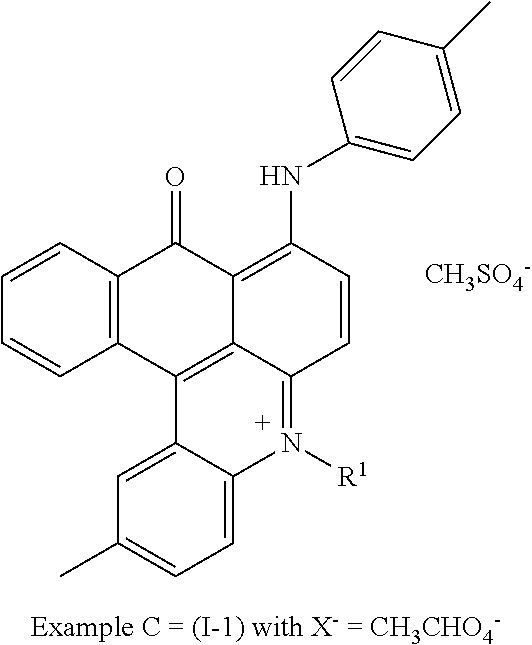
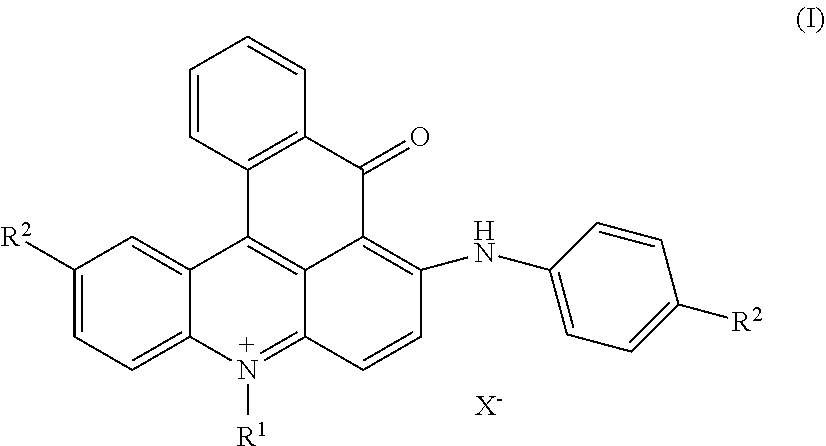
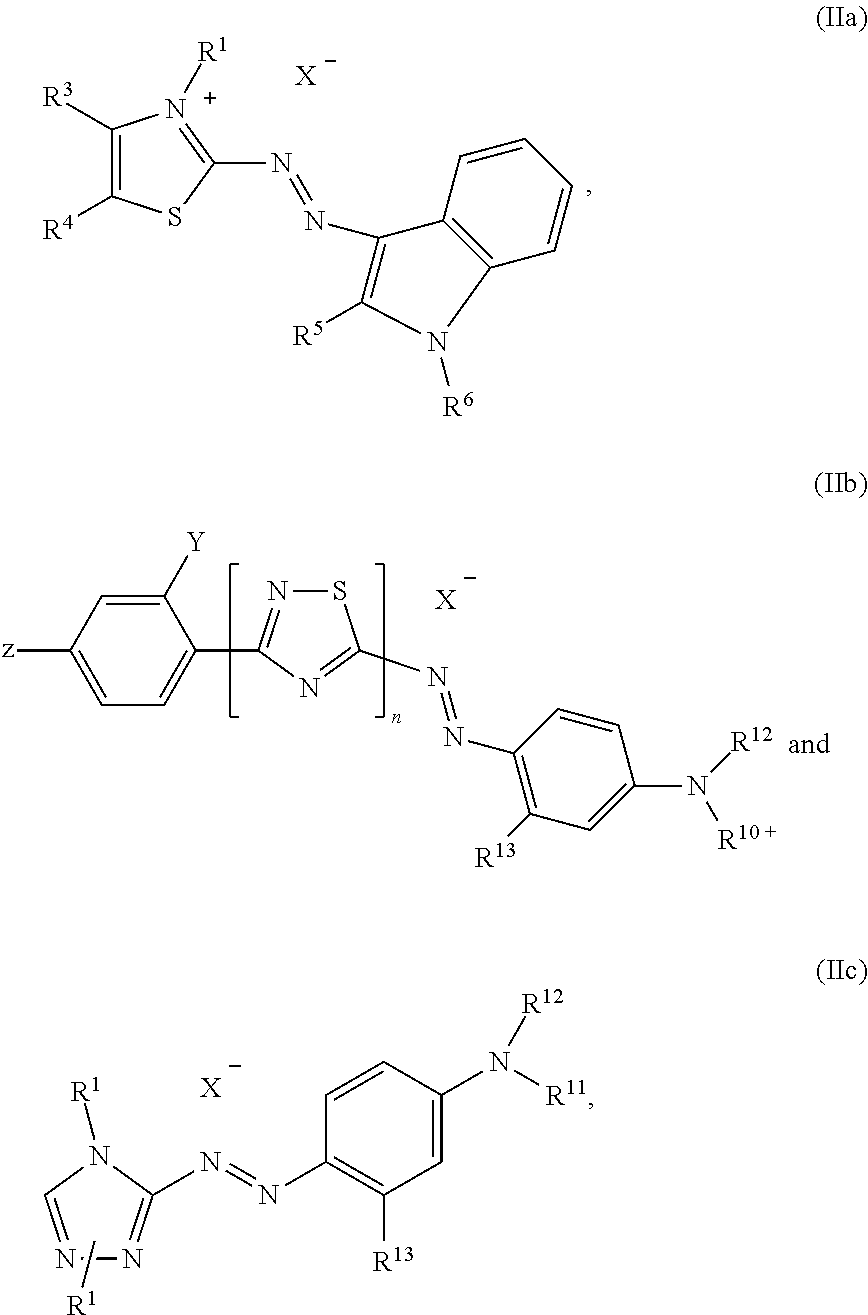


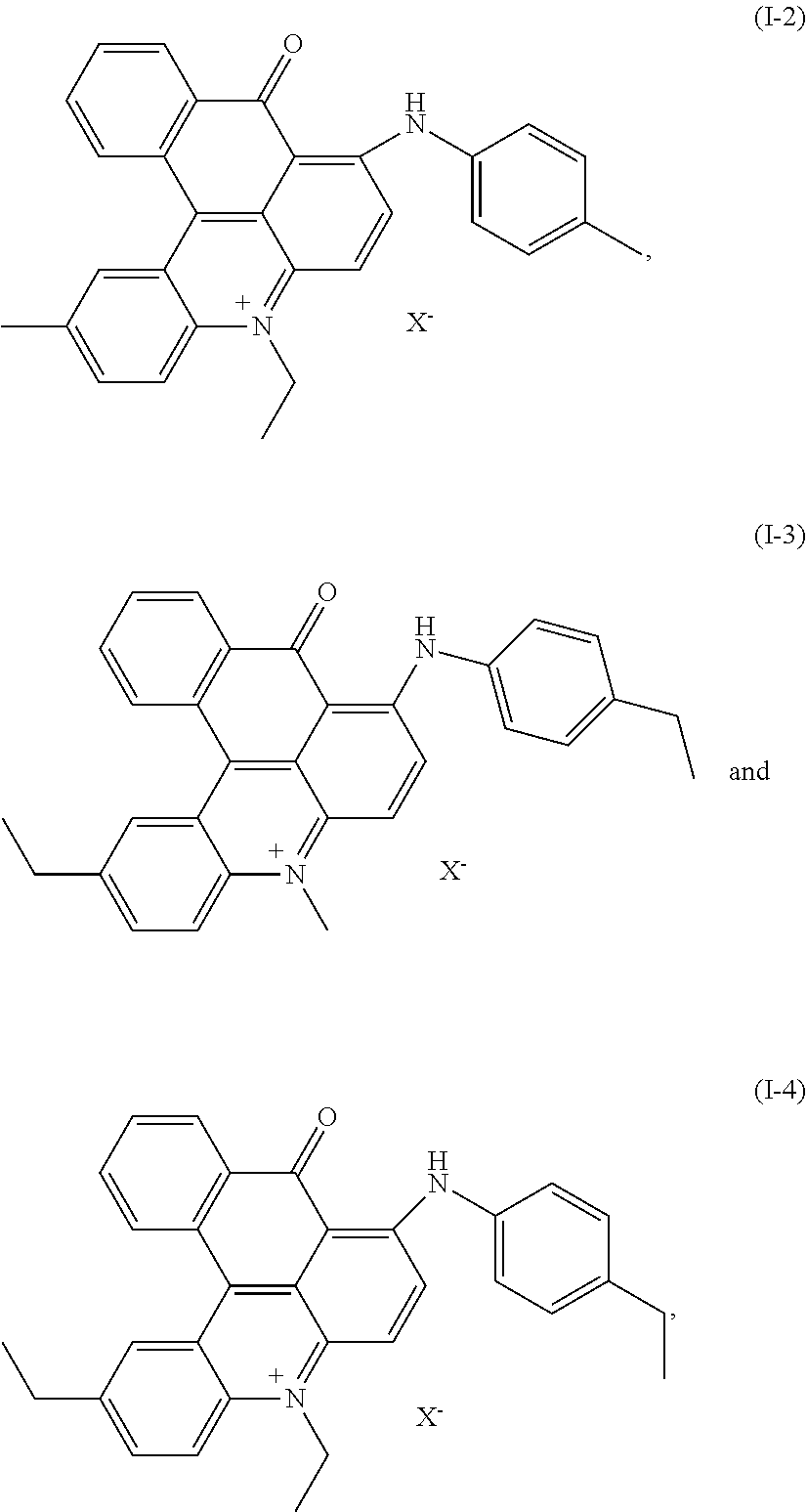

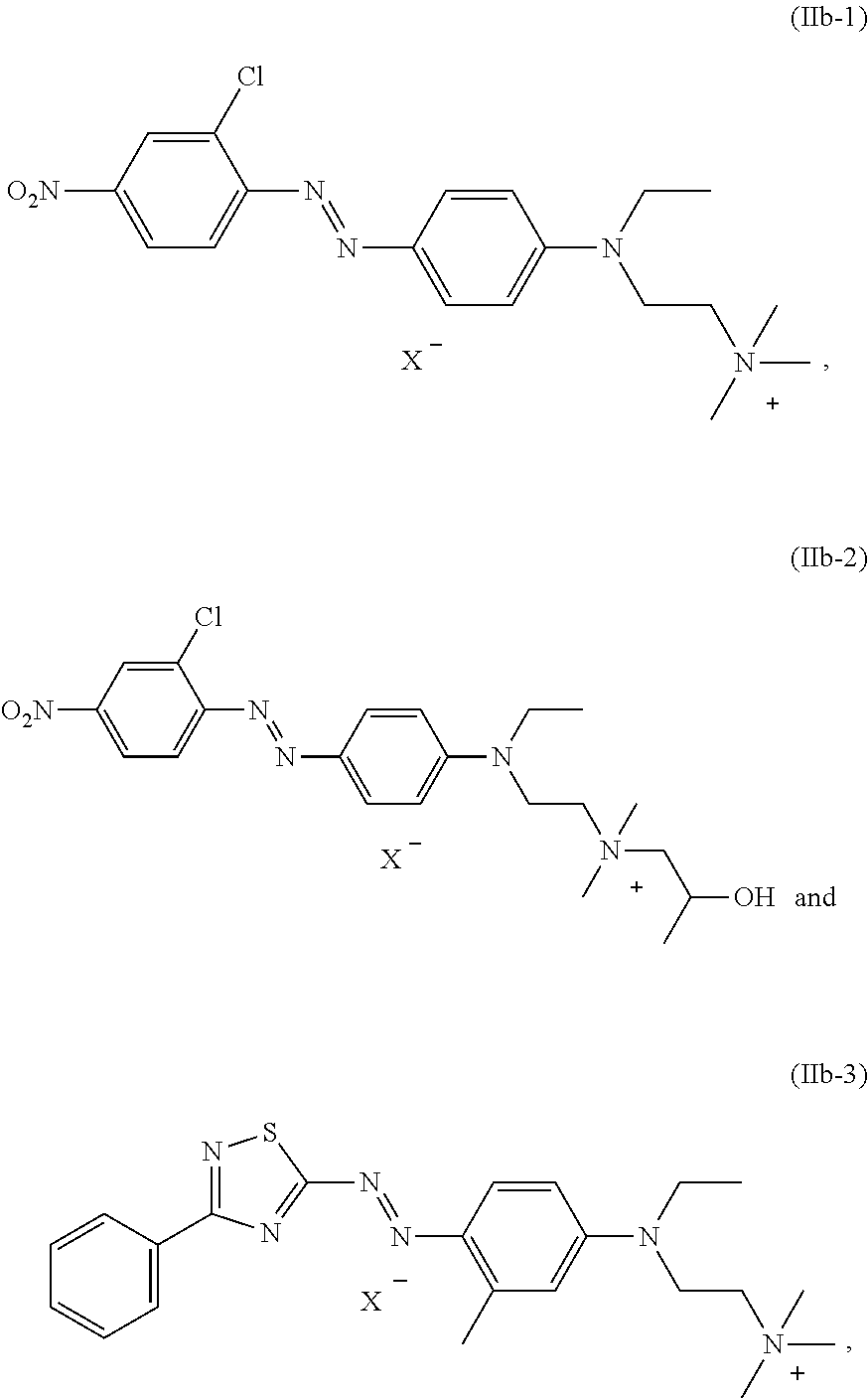
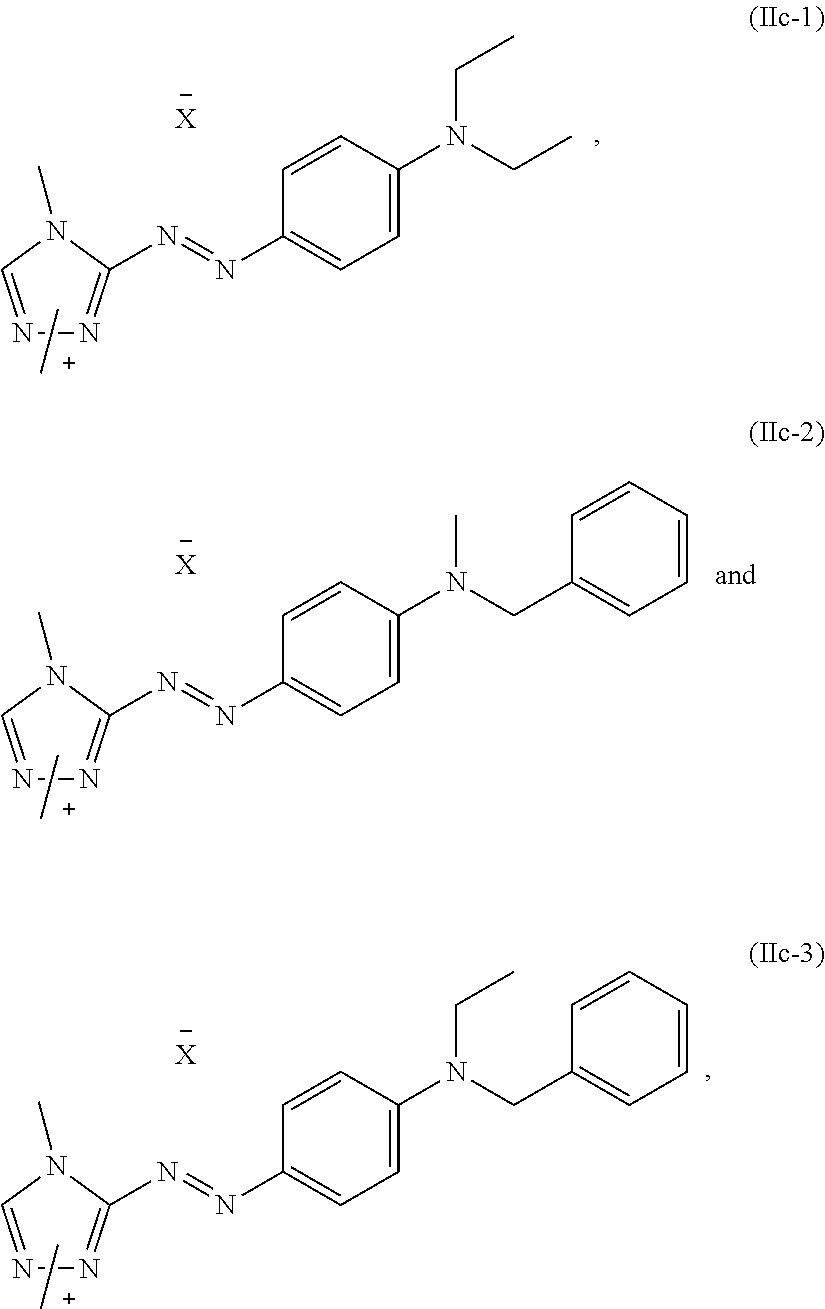
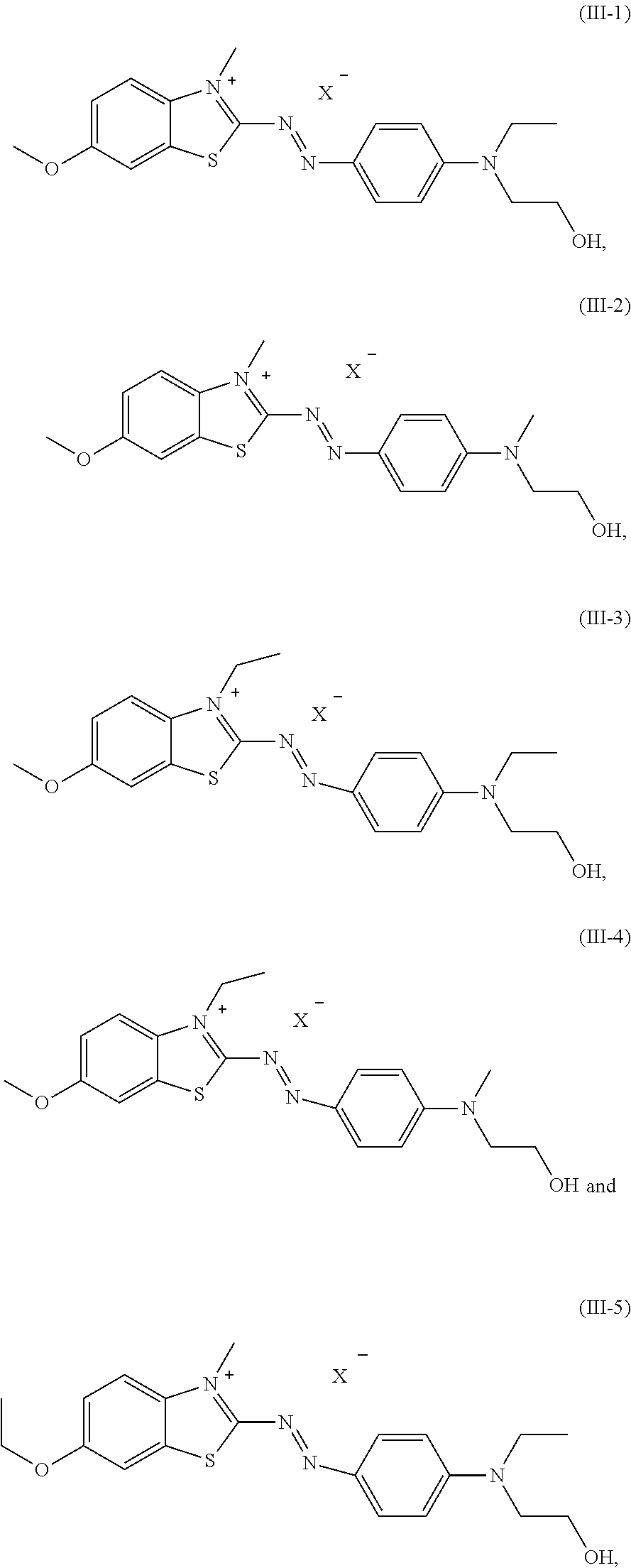
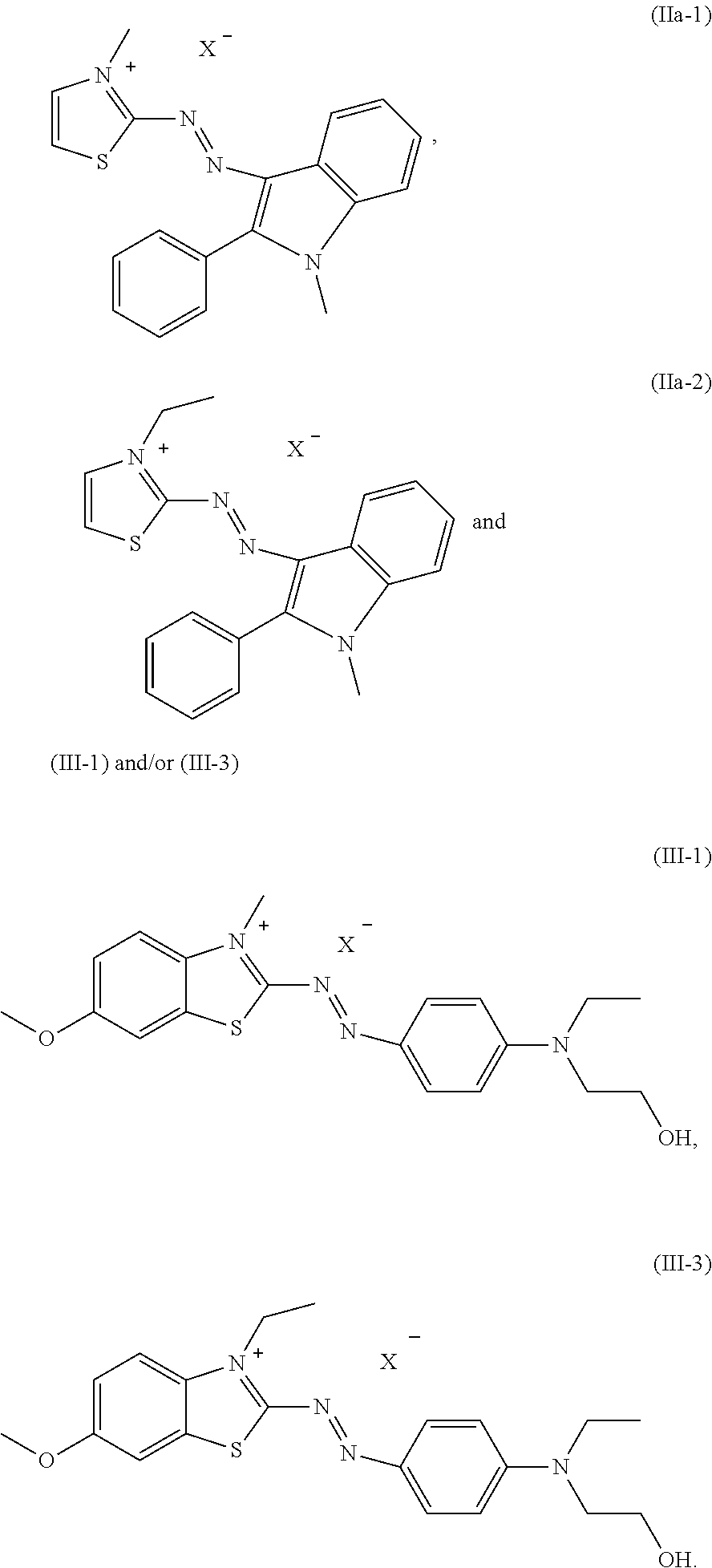
XML
uspto.report is an independent third-party trademark research tool that is not affiliated, endorsed, or sponsored by the United States Patent and Trademark Office (USPTO) or any other governmental organization. The information provided by uspto.report is based on publicly available data at the time of writing and is intended for informational purposes only.
While we strive to provide accurate and up-to-date information, we do not guarantee the accuracy, completeness, reliability, or suitability of the information displayed on this site. The use of this site is at your own risk. Any reliance you place on such information is therefore strictly at your own risk.
All official trademark data, including owner information, should be verified by visiting the official USPTO website at www.uspto.gov. This site is not intended to replace professional legal advice and should not be used as a substitute for consulting with a legal professional who is knowledgeable about trademark law.